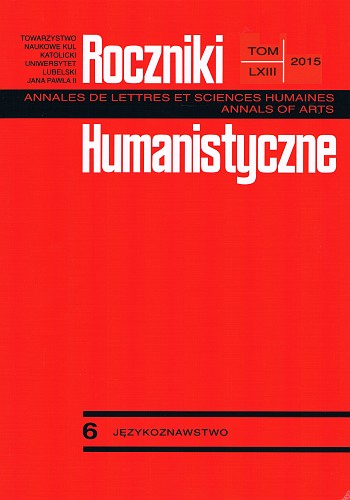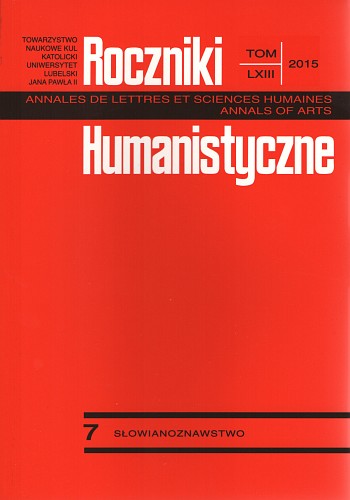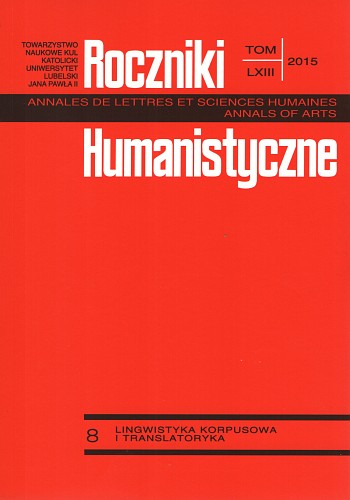




Keywords: orphanage;mother;cross;miracle;Divine Providence;faith;spirituality;
The paper is devoted to the analysis of the motif of the Lord's Ways in the story Sunny Pima by Iryna Piatnickoy. Iryna Piatnickoy is a contemporary Russian writer whose writings are mainly focused on spiritual realia as well as on creating spiritual values. In her story, the writer presents the fate of two children from an orphanage; she shows their unshaped interior, which, without any resistance, is open to the contact with the sacrum. On the basis of Stas, one of the children in the orphanage, Iryna Piatnickoy demonstrates how much can be done by an adult person who shows the correct way to the neophyte. A very important place in the story is given to the symbol of the cross, which possesses a number of different connotations in the Christian culture. In Pima Solniecznyj the symbol of the cross is presented in a visual and a verbal way.
More...
Keywords: globalization;church;state;culture;man;
Relationship the Roman Catholic Church to the globalization is different than Russian Church. Rome can see threatening in the economic, Moscow in cultural and anthropological sphere. For the Russian church is important a cooperation with the government. Government and the Orthodox are two factors of the identification of Russian. Historian Aleksy Harin ar confronting the civilization with the empire. He is identifying the civilization with values. Political scientist Andrej Okara claims that Russia identifiction itself through the confrontation with the West. The Eastern culture is different than eastern in understanding the meaning of the life and death. Olympius prior (Kastalski) notices positive sides of the globalization. The oblivion characteristic of the globalization is summoning the memory, the standardization of the human appearance is giving rise to longing for the icon.Defects in the globalization are shown by Russian thinkers in the space not in the time, their ontology is important, not an evolution. Therefore globalization which has historical features, however for her ontology is from time immemorial unchanging.
More...
Keywords: Kievneo-classicis;cultural syncretism;paratext;intertext;strategy „of play” by somebody else’s text;intercultural connections;
This article concerns itself with the way(s) the Kiev neo-classicists school treated many cultural sources of foreign origin. The essay argues that cultural syncretism, defined as organic blending – in artistic texts – of separate elements, constitutes a specific form of expression through which to render the idea of dialogue and harmony of diversities. This is exemplified by Neo-classical poetry analyzed with regard to multicultural elements existing on various levels of the text (foreign words, the works’ titles; mottoes, names etc.) and by intertextual analysis. The article discusses semantics, origin, ways of deployment and symbolism of incorporated elements as well as their function in determining the meaning(s) of the text. It also demonstrates the role of creative strategy of ‘playing’ with a different text, introduced into poetry as intertext. This study takes into consideration the function of footnotes as one type of paratexts. An examination of cultural syncretism indicates an integrating role of culture and a system of humanist values the Neo-classicists promoted, simultaneously referring to European classics and updating their universal values. The author claims that cultural syncretism – in an immanent way – stresses the idea of equality of intercultural relationships and also constitutes a conceptual model of communication whose basic categories are represented by dialogue, tolerance, harmony and solidarity. This model’s practical value lies not only in the realm of art, but also in the social sphere and international relationships.
More...
Keywords: modernism;Polish literature;Ukrainian literature;“Ukrainian neoclassicists”;Europeanisation;
This article is devoted to the reflection on the Polish-Ukrainian literary connections in the 1920s. In the light of the research results there can be observed a noticeable impact of Polish literature on Ukrainian literature and Ukrainian literary circles, which intensified at the turn of the nineteenth century. Most frequently Polish influence manifested in mediation in the transfer of the latest modernist tendencies of Western culture. However, Poland was often presented as a successful model of cultural development. This work also shows that the reception of Polish literature was present in the Soviet Ukraine as well, and it was most noticeable in the literature of Kievian Neoclassicists.
More...
Keywords: Old-Bulgarian/Old-Church-Slavonic – Polish dictionaries and lexicons;literary translation;Slavia Orthodoxa;
The paper presents a commented review of published in Poland textbooks, self-study books of Old-Church-Slavonic and lexicographical studies, being an evidence of scientific reflection on language and culture of the Slavia Orthodoxa area. In the first part of the paper, there are presented studies (mainly textbooks) used in practice of teaching process in universities; neverthless of their current availability and popularity, almost all of the titles edited from the beginning of the 20th cent., are described. The second part is devoted to a detailed description of dictionaries, lexicographical studies, and various kinds of encyclopaedias. Different methodological approach, selection of source texts (liturgical ones, particular codices etc.) and cultural phenomena (customs, rituals etc.), being the data base for the studies, as well as specificity of entries’ construction and their authors’ commentary are presented and analyzed.The appendix is a register/list of almost 50 titles of translatory aids of both mentioned above groups.
More...
Keywords: translation;reception;literature;Slavia Orthodoxa;literature of Orthodox Slavs;the Old Serbian texts;antologies;
This work deals with the problem of the reception of the former literature of the Slavia Orthodoxa circle in Poland, which is an issue folded, multifaceted, closely connected with the specificity of the two cultural spaces, seemingly different, but as it turns out, not so distant or different in their traditions. The issue of the translation of literature of Orthodox Slavs is discussed on the example of the Old-Serbian texts, given the criterion of presence and absence of these texts in Polish circulation readership.
More...
Keywords: proverb;trade;artifact;symbolic function of objects;folk phraseology;stereotypes of ritual and everyday actions;anthropomorphic metaphor;evaluativity;
The article focuses on the proverbs and sayings connected with ancient skills and symbolic artifacts naming in the Russian, Polish, Ukrainian and Belorussian languages. The ways of conceptualization of technological processes, tools, housekeeping and trade equipment in the language of folk culture (folk and dialectal phraseology, similes, idioms, proverbs, sayings, folk and everyday superstitious beliefs and legends) are considered. The processes of metaphoric reframing of some household items, plates and dishes in particular are covered; their semiotic function in ritual, moral and ethical presentations is established. The stereotypes of everyday and mythological actions of the ancient skills representatives, their mutual relations and evaluation, as a rule, pejorative one, on the side of the society are revealed.The process of object and agent cultural codes symbolization is connected with certain social ideas (own – alien, exchange, justice, ability-inability, good (profitable) – bad (unprofitable) trade, rules, restrictions, recommendations etc.). One and the same characteristic feature of the object in different linguocultures may generate several different symbols and image and evaluative contexts. Household items, apart from their substantive content and practical function, may have semiotic, ritual, anthropomorphic functions, that is to denote personality traits, appearance, emotions, intelligence, family relations etc., code oppositions full-empty, whole-part, old-new, function as a way of measurement of artifacts-containers (spoon-bucket, spoon-barrel, crockery-sack, big-small etc.).
More...
Keywords: concept;CUNNING;proverbs;national cultures;
The article deals with the contrastive research of concept “cunning” on the material of Ukrainian, Russian, English and Italian proverbs. In question universal and ethnic semantic components of the concept are described; the attempt is made to cast light on its cognitive connections, the status in the conceptual spheres of the national cultures. Based on the language facts the conclusions are made about ethnic peculiarities of world outlook, cultural and value orientations of the nations.
More...
Keywords: Ukrainian language;teaching materials;coursebook;teaching process;
This article is an attempt to assess selected glottodidactic materials (textbooks) for learning the Ukrainian language, used in the teaching process at the level of higher education since the 1990s. In the first part of the article the types of glottodidactic materials are presented and their place and function in the processes of teaching and learning a foreign language is discussed. In the second part selected textbooks for learning the Ukrainian language are assessed, taking into account external criteria concerning, for instance, Curricula, and internal, related to the needs of a student or teacher.
More...
Keywords: Gorky;Rutenberg;correspondence;historical problems;
The article Spiridonova L. the analysis of correspondence with M. Gorky and P. Rutenberg an engineer, a prominent figure of the socialist revolutionary party in 1905-1909 ag,, one of the founders of an independent Jewish state. It lasted from 1909 to 1936 and covered a variety of topics: murder of the priest Gapon, the activities of the socialist party in the early twentieth century, the Russian-Italian cultural ties, the construction of the first electric company in Palestine, through bitter cultural process in Eretz-Israel. As an example, are two unknown letters of 1928, in which Gorky and Rutenberg exchange opinions about released in the USSR historical books about the murder of Gapon. In General, the article reveals an unknown Chapter in the history of the twentieth century.
More...





Keywords: analogy;relationship;meaning;language;metaphysics;cognitive realism;
Analogia na terenie filozofii realistycznej jest podstawowym sposobem poznania bogactwa świata osób i rzeczy i chroni ludzkie poznanie przed redukcjonizmem. Poznanie analogiczne jest ugruntowane na analogicznym sposobie istnienia bytów, a zatem jest genetycznie i strukturalnie związane z rzeczą. Analogia pozwala ogarnąć poznawczo tak poszczególne jednostkowe rzeczy, jak i całość oraz złożoność świata natury i kultury, nie tracąc równocześnie z pola widzenia zróżnicowania istniejących w nim bytów. Nabudowana na analogii teoria znaczenia terminów językowych daje podstawę ujęcia w znaczeniu danej nazwy najgłębszej struktury rzeczy, gdyż wskazuje na koniecznościowy układ treści znaczonej rzeczy, a co stanowi o właściwym i adekwatnym rozumieniu oznaczanej przez nazwę rzeczy.
More...
Keywords: ontology;predicates;primitives;terms in ontologies;natural language vocabulary;
The article deals with two terms: “primitives” and “predicates” found in technical reports on ontology, on natural languages and in programming languages. The way they are used seems to confirm the Latin phrase: Si duo dicunt idem non est idem. However, one must attenuate this supposition which is due to the fact that the descriptions of ontologies, of the programming code and of the natural language texts are made in formal language. The obtained descriptions have two aspects: ‘formal’ and ‘lexical’ or ‘semantic’. Both predicates and primitives appear in linguistics and computer science on the formal level, and not on the ‘lexical’ one. A glance at the Charter of Fundamental Rights of the European Union as the base-text used to develop a micro-ontology leads to the conclusion that the authors introduce the concept of dignité humaine ‘human dignity’ by an arbitrary stipulative definition rather than by reporting one. The meaning assigned to this term does not coincide with any of the registered meanings of this expression in the standard language
More...